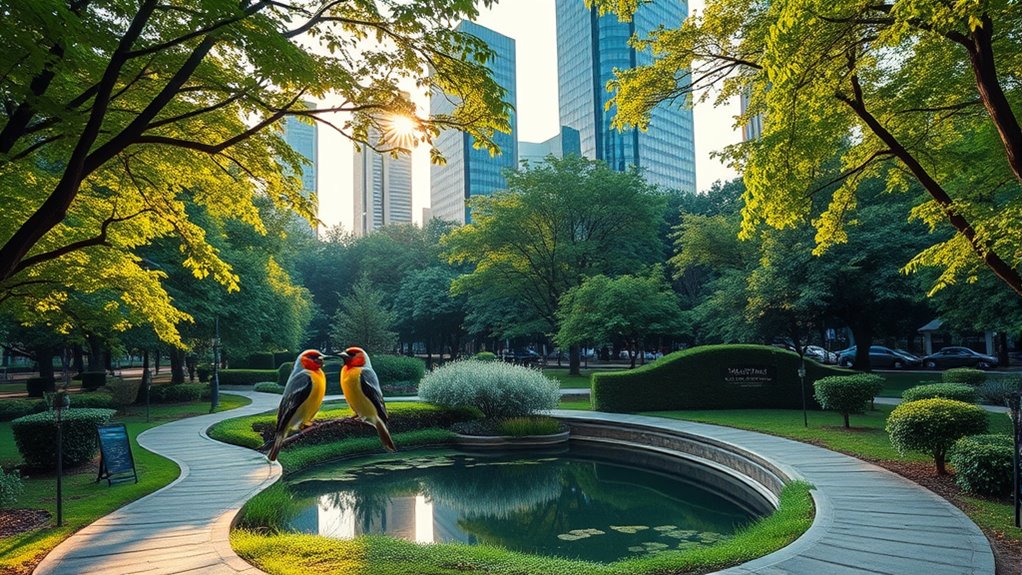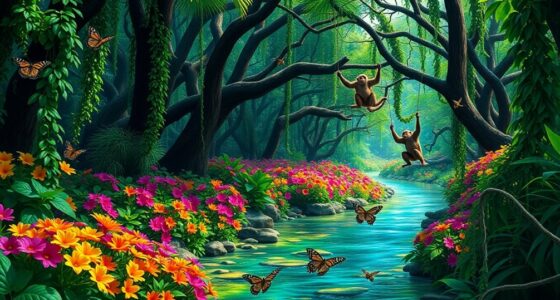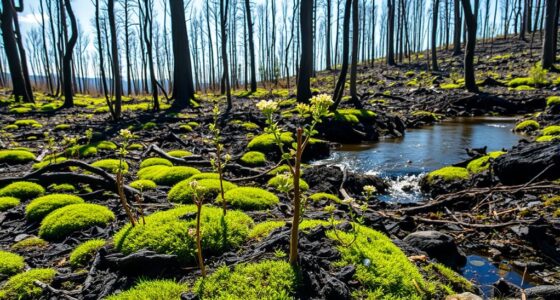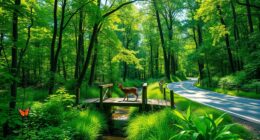Urban ecosystems are lively spaces where city wildlife and green areas coexist and adapt. Parks, green roofs, and natural corridors provide essential habitats, helping animals find food, shelter, and breeding spots. These green spaces also improve air quality, reduce heat, and support biodiversity, making cities healthier for both wildlife and residents. By recognizing these vibrant natural systems, you can see how cities function as dynamic, thriving environments—discover more about the important role of green spaces.
Key Takeaways
- Urban ecosystems are vibrant environments where diverse wildlife coexists with green spaces like parks and gardens.
- Thoughtful city planning enhances biodiversity through green infrastructure, corridors, and native plantings.
- Green spaces support pollinators, improve air quality, and mitigate urban heat islands.
- Incorporating sustainable design strategies promotes ecological stability and resilience in cities.
- Recognizing urban ecosystems emphasizes their ecological importance and benefits for residents’ well-being.
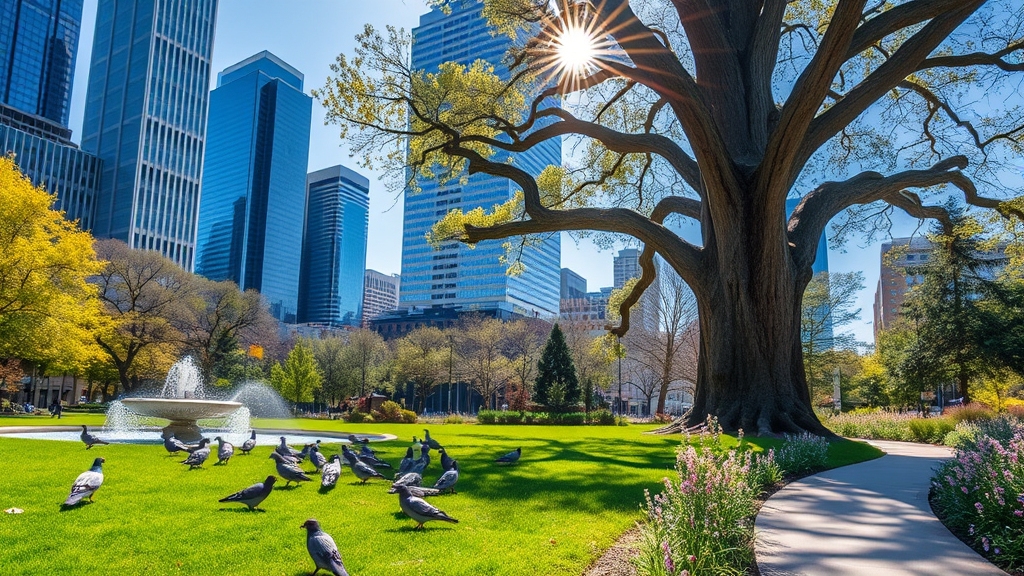
Have you ever considered how cities function as dynamic ecosystems? It’s easy to think of urban areas as concrete jungles, but they’re much more than that. Cities are vibrant hubs of life, hosting an astonishing array of wildlife and green spaces that contribute to urban biodiversity. When you look beyond the skyscrapers and busy streets, you’ll notice birds nesting in trees, insects pollinating plants, and small mammals scurrying through parks. These elements form an intricate web of interactions that keep urban environments resilient and thriving. Recognizing this, city planning becomes a critical tool to foster and sustain such biodiversity. Thoughtful city planning involves integrating parks, green roofs, roadside plantings, and natural corridors into urban landscapes. These features aren’t just aesthetic; they serve as essential habitats for local wildlife, providing food, shelter, and breeding spaces. By prioritizing green infrastructure, you help create corridors that connect isolated patches of green, allowing animals and plants to move freely and maintain genetic diversity. This approach also benefits residents by improving air quality, reducing urban heat, and offering peaceful retreats amid bustling city life. When urban planning emphasizes green spaces, it transforms cities into living ecosystems that support both human and ecological health. It’s about designing cities with nature in mind—embedding parks and natural elements into neighborhoods and ensuring they’re accessible to everyone. This kind of planning requires a shift from traditional, car-centric designs to more sustainable, nature-inclusive strategies. For example, incorporating rain gardens and permeable pavements helps manage stormwater while providing habitat for insects and amphibians. These features demonstrate how city planning can actively promote urban biodiversity and create more sustainable, resilient urban environments. Additionally, urban green spaces serve as vital refuges for pollinators and other beneficial insects, which are crucial for maintaining ecological balance. Incorporating native plant species into urban landscaping further supports local wildlife by providing familiar food sources and habitats. Understanding the importance of biodiversity in urban environments highlights how diverse species contribute to ecological stability and resilience. A deeper understanding of urban ecosystems reveals how interconnected natural processes are within city environments. Recognizing the role of green infrastructure can help cities develop more effective strategies for conservation and climate adaptation. As you explore your city, pay attention to how green spaces are integrated into the urban fabric. Notice the variety of plants, the presence of birds and insects, and how these elements coexist with built structures. This interconnectedness is the essence of urban ecosystems. When city planners prioritize the preservation and expansion of green spaces, they’re recognizing that cities can support a diverse range of life forms. It’s a proactive move toward balancing development with conservation, ensuring that urban ecosystems remain healthy and vibrant for generations to come. In the end, understanding the role of urban biodiversity and thoughtful city planning helps you appreciate the complex, living systems that thrive within your city. It reminds you that even in dense urban areas, nature finds ways to flourish, making cities better places to live for all species—human and non-human alike.
Frequently Asked Questions
How Do Urban Ecosystems Impact Local Air Quality?
You might wonder how urban ecosystems affect air quality. By adding green spaces, you help improve air quality through pollution mitigation, as plants filter pollutants and produce oxygen. These ecosystems also support pollution mitigation efforts, reducing airborne contaminants. When you incorporate trees and parks into city planning, you actively contribute to cleaner air and healthier environments, making urban areas more livable and sustainable.
What Are the Best Practices for Creating Wildlife Corridors?
Imagine a city’s greenway as a crucial blood vessel connecting isolated neighborhoods. To create effective wildlife corridors, you should prioritize native plantings that support local species. Ensuring habitat connectivity allows animals to travel safely, find food, and breed. Incorporate continuous green pathways, minimize barriers, and restore natural landscapes. These practices help sustain urban biodiversity and create resilient ecosystems, turning city spaces into thriving habitats rather than barriers.
How Can Residents Help Support Urban Biodiversity?
You can support urban biodiversity by getting involved in community projects that promote native plantings, which provide essential habitats for local wildlife. Plant native species in your yard or participate in neighborhood gardening efforts. Encouraging community involvement helps create green spaces that attract pollinators and birds. By working together, you and your neighbors can foster a healthier, more vibrant ecosystem right in your city, benefiting both wildlife and residents.
What Are Common Challenges in Maintaining Urban Green Spaces?
You face challenges in maintaining urban green spaces, especially with invasive species that threaten native plantings. These invasive plants often outcompete local species, reducing biodiversity. Additionally, limited space, pollution, and frequent human activity can harm the health of green areas. To overcome these issues, you should focus on controlling invasive species, planting native species, and promoting community involvement to sustain vibrant, resilient urban green spaces.
How Do Urban Ecosystems Influence Local Climate Regulation?
You see how urban ecosystems shape local climate regulation by influencing urban microclimates and temperature moderation. They cool down hot city areas through shade, transpiration, and green cover, reducing heat islands. These ecosystems also help retain moisture and improve air quality, creating more comfortable environments. By fostering biodiversity and natural processes, your city can better adapt to climate change, making urban spaces healthier, cooler, and more resilient.
Conclusion
As you walk through bustling city streets, remember that urban ecosystems blend concrete and creatures, chaos and calm. While skyscrapers tower overhead, tiny green patches and wildlife thrive beneath them, reminding you that nature persists amidst human progress. This delicate balance shows that cities aren’t just concrete jungles—they’re vibrant habitats. Embrace the coexistence, recognizing that urban spaces are as much about wildlife and green spaces as they are about commerce and development.
